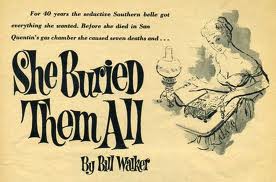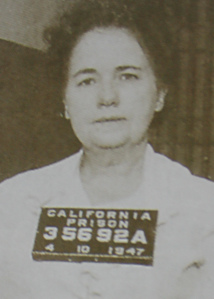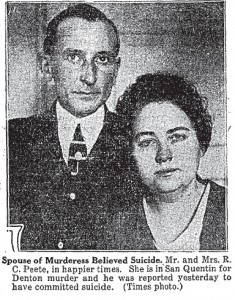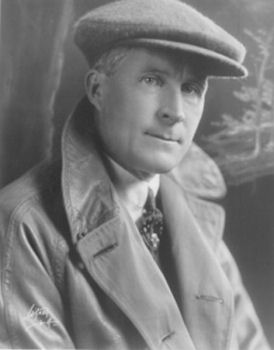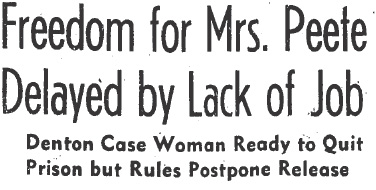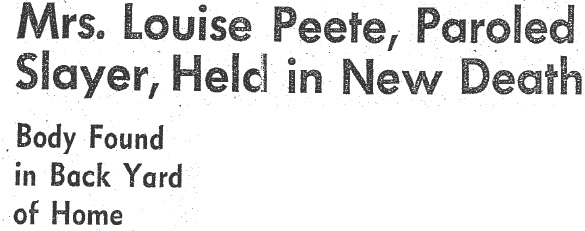Louise Peete’s trial began on April 23, 1945.
Louise had never denied burying Mrs. Margaret Logan’s body in a shallow grave at the deceased woman’s Pacific Palisades home, but she told several colorful stories about how Logan ended up dead in the first place.
As in her first murder trial for the slaying of Jacob Denton over twenty years earlier, Peete claimed to be broke and was assigned a public defender, Ellery Cuff. Cuff had an uphill battle, the evidence against Peete was compelling.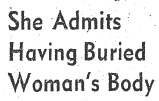
For the most part Louise sat quietly as the prosecution drew deadly parallels between the 1920 murder of Jacob Denton and the 1944 murder of Margaret Logan; however, she disrupted the trial during testimony by police chemist Ray Pinker. From the witness stand Pinker testified to a conversation between Louise and LAPD homicide captain Thad Brown. (In 1947 Thad Brown’s brother, Finis, would be one of the lead detectives in the Black Dahlia case.)
 Pinker said that prior to the discovery of Mrs. Logan’s body in a shallow grave in the backyard of her home, Brown had faced Peete and said: “Louise, have you blow your top again and done what you did before?” To which she replied: “Well, my friends told me that I would blow my top again. I want to talk to Gene Biscailuz (L.A. County Sheriff).” Louise spun around in her chair at the defense table and shouted “That is not all of the conversation.” Her attorney quieted her.
Pinker said that prior to the discovery of Mrs. Logan’s body in a shallow grave in the backyard of her home, Brown had faced Peete and said: “Louise, have you blow your top again and done what you did before?” To which she replied: “Well, my friends told me that I would blow my top again. I want to talk to Gene Biscailuz (L.A. County Sheriff).” Louise spun around in her chair at the defense table and shouted “That is not all of the conversation.” Her attorney quieted her.
Pinker testified to how he had found the mound covering Mrs. Logan’s body. He said that he had observed a slight rise in the ground which was framed by flower pots. The cops didn’t have to dig very deep before uncovering Margaret Logan’s remains. When Louise was asked to face the grave she turned away and hid her face with her handbag.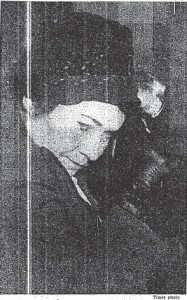
All of Pinker’s testimony was extremely damaging to Peete’s case. In particular he said he tested a gun found Mrs. Peete’s berdroom, and when he tested the bullets they were consistent with the .32 caliber round found lodged beneath the plaster in the living room of the Logan home.
The prosecution’s case was going to be difficult to refute. It must have been a tough call for the defense when they decided to allow Louise to take the stand. Louise could be volatile and unpredictable.
Louise testified that Mrs. Logan had phoned her to ask if she’d keep house for her while she was working at Douglas Aircraft Company. Louise went on to say that when she arrived at the Logan home she found Margaret badly bruised, allegedly the result of Mr. Logan kicking her in the face.
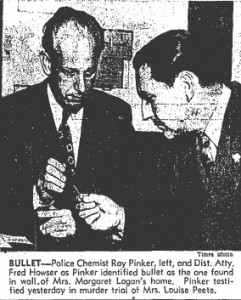 Mr. Logan would be unable to refute any of Louise’s allegations because he had died, just days before, in the psychiatric hospital where he was undergoing treatment. Logan had been committed to the hospital by Louise, masquerading as his sister!
Mr. Logan would be unable to refute any of Louise’s allegations because he had died, just days before, in the psychiatric hospital where he was undergoing treatment. Logan had been committed to the hospital by Louise, masquerading as his sister!
Logan’s death was a boon for Louise and she took full advantage of it by blaming him for his wife’s death. Louise was asked to recreate her story which had Arthur Logan shooting and battering his wife, but she appeared to be squeamish. When she was shown the murder gun and asked by the judge to pick it up to demonstrate how Arthur Logan had used it to kill his wife, Louise said: “I will not take that gun up in my hand.”
Louise’s attorney tried valiantly to contradict the evidence against his client. Would the jury believe him and acquit her?
In his summation District Attorney Fred N. Howser addressed the jury:
“Mrs. Peete has violated the laws of man and the laws of God. She killed a woman because she coveted her property. Any verdict short of first degree murder would be an affront to the Legislature. If this crime doesn’t justify the death penalty, then acquit her.”
The jury of 11 women and 1 man found Louise Peete guilty of the first degree murder of Margaret Logan. With that verdict came a death sentence.
Judge Harold B. Landreth pronounced the sentence:
“It is the judgement and sentence of this court for the crime of murder in the first degree of which you, the said Louise Peete, have been convicted by the verdict of the jury, carrying with it the extreme penalty of the law, that you, the said Louise Peete, be delivered by the Sheriff to the superintendent of the California Instution for Women at Tehachapi. There you will be held pending the decision of this case on appeal, whereupon said Louise Peete be delivered to the warden of the State Prison at San Quentin to be by him executed and put to death by the administration of lethal gas in the manner provided by the laws of the State of California.”
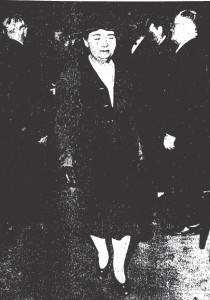 It was reported that Louise took her sentence “like a trouper”.
It was reported that Louise took her sentence “like a trouper”.
On June 7, 1945, Louise Peete began her journey from the L.A. County Jail to the women’s prison at Tehachapi to wait out the appeals process.
Louise lost the appeals which may have commuted her death penalty sentence to life in prison. On April 9, 1947 an eleventh hour bid to save her life was made to the U.S. Supreme Court. The court denied the appeal.
Louise would die.
A crush of reporters spent time with Louise on her last night; among them was, of course, Aggie Underwood.
Aggie had interviewed Louise numerous times over the years, and she managed to get at least two exclusives. In her autobiography, NEWSPAPERWOMAN, Aggie devoted a few pages to her interactions with Louise, which I’ll share:
“With other L.A. reporters, I interviewed her there for the last time before she was taken to San Quentin to be executed April 11, 1947.”
“Like other reporters, I suppose I was striving for the one-in-a-million chance: that she would slip, or confess either or both murders, Denton’s in 1920 and Mrs. Logan’s on or about May 29, 1944.’
Louise would not slip; but Aggie gave it her best try. Interestingly, Aggie said that she never addressed Louise as anything but Mrs. Peete. Why? Here is her reasoning:
“I called her Mrs. Peete. A direct attack would not have worked with her; it would have been stupid to try it. She knew the homicide mill and its cogs. She had bucked the best reporters, detectives, and prosecutors as far back as 1920, when, as a comely matron believed to be in her thirties, she had been tagged the ‘enigma woman’ by the Herald.”
“So I observed what she regarded as her dignity. Though I was poised always for an opening, I didn’t swing the conversations to anything so nasty as homicide.”
And in a move that would have occurred only to a woman, Aggie spent one of her days off finding a special eyebrow pencil for Louise:
“…with which she browned her hair, strand by strand. I didn’t go back to jail and hand it to her in person. Discreetly I sent it by messenger, avoiding the inelegance of participating in a utilitarian device to thwart nature which had done her a dirty trick in graying her. Royalty doesn’t carry money in its pockets.”
About Louise, Aggie said: “She wasn’t an artless little gun moll.” No, she wasn’t.
Lofie Louise Preslar Peete was executed in the gas chamber on April 11, 1947– it took about 10 minutes for her to die. She was the second woman to die in California’s gas chamber; two others would follow her.
Peete is interred in the Angelus-Rosedale Cemetery in Los Angeles.
NOTE: On March 9, 1950 the DRAGNET radio program aired an episode called THE BIG THANK YOU which was based on Louise Peete’s cases. Enjoy!
http://youtu.be/5ddEOaa4w50
NEXT TIME: Dead Woman Walking continues with the story of the third woman to perish in California’s lethal gas chamber, Barbara Graham.


